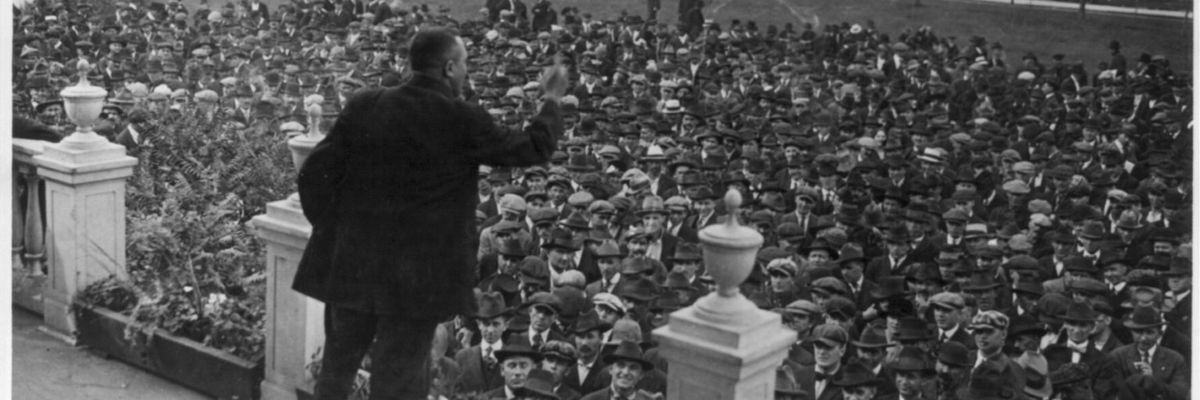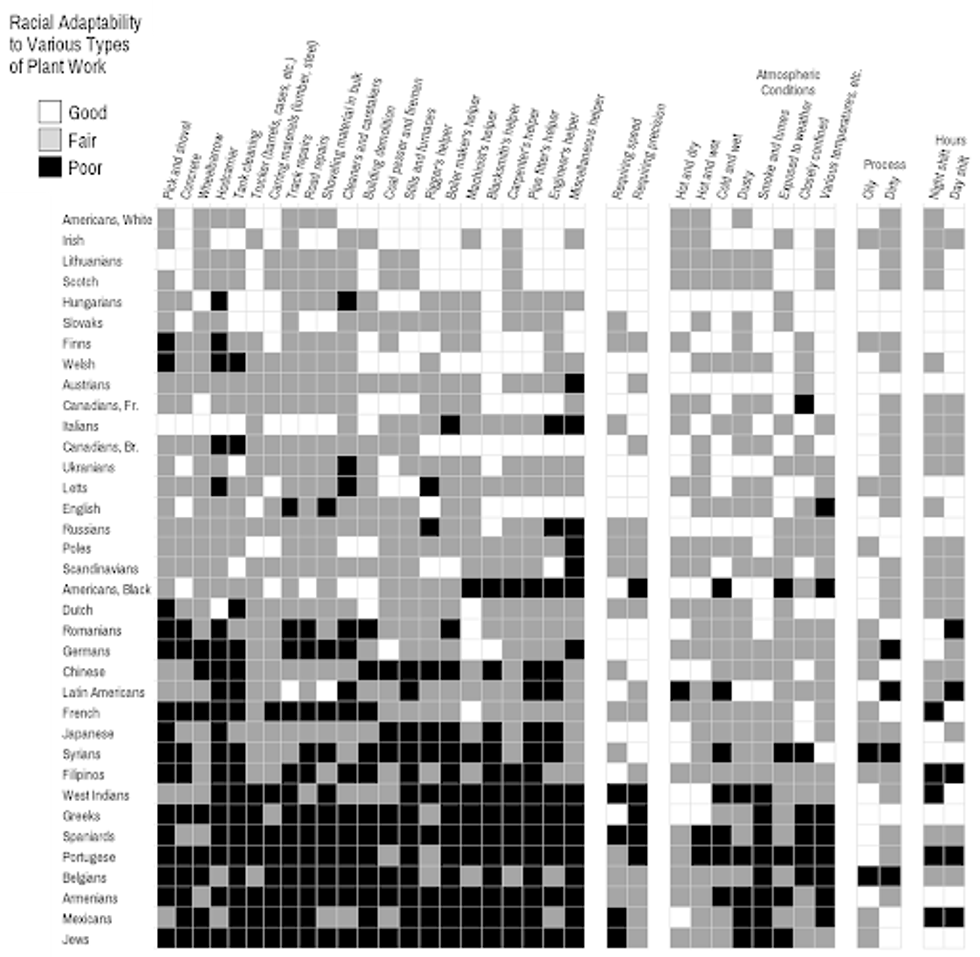In 1919, more than 350,000 steelworkers went on strike to secure an eight-hour work day. They were crushed by employers who used thugs, government injunctions, and troops to defeat them. The industry also relied heavily on ethnic divisions to undermine the union, a tactic that worked for the next 25 years. (The United Steelworkers of America, launched in 1942, was able to overcome those divisions to form a powerful union that still thrives today.)
As we enter Black History Month, it is important to understand how management race science was developed to divide and conquer the workforce as it struggled against long odds to form labor unions.
Within a few years of the 1919 steel strike, race pseudoscientists had developed racial hierarchies to delineate who was fit, by birth, to do different kinds of jobs. The goal was to isolate individual workers from the larger group of workers in order to undermine solidarity. The chart below, produced in 1926 for the Central Tube Company in Pittsburgh, shows how the workforce was carved up into an intricate hierarchy of talents based on supposedly innate racial or ethnic talents. Who would have guessed that Slovaks were innately good at track cleaning?

At that time, ethnicity and race were viewed by pseudoscience as the same. Religion was a race. Language groups were races. Skin color was a race. In the chart, 36 “races” are evaluated along 36 different work traits and skills. Each race was believed to have in-bred talents and traits that the “scientists” of that era believed they could statistically identify. The more blank “white” boxes next to a “race,” the greater the skill set. American whites were believed by “science” to be the fittest of the fit in this pseudo-Darwinian hierarchy of talent. After all, they believed themselves to have conquered the continent, won World War I, and created the largest, most dynamic economy in the world.
Note that American Blacks were not at the bottom of the list, which seems to run counter to that era’s aggressive white-supremacy efforts, notably the rise of the KKK, the increase in the number of lynchings, and the re-segregation of the federal government by President Woodrow Wilson. But for the corporate lords, Blacks were viewed as a “race” of hard workers. And their position in the middle of the hierarchy may reflect the role they played during the 1919 steel strike. At that time Black workers, who had been excluded from membership by nearly all of the striking craft unions, served as strikebreakers in Gary, Indiana, (leading to a race riot and martial law.) Their supposedly innate racial attributes may have included management’s belief that Black workers would continue to shun unions or at least racist unions.
Not so for the Jews, who were vanquished to the very bottom. Antisemitism was an accepted norm during this period, especially within the more privileged corporate class. (Henry Ford wrote many an article lambasting Jews.) Keeping Jews from working in the steel industry may also have been connected to the image of urban ghettos, teaming with immigrants from Eastern Europe and filled with crime and disease. It likely also may have reflected the stereotype that Jews were bookish and unfit for strenuous labor.
Since the 1850s, the “race” scientists have been trying to prove that racial differences are biological demonstrations of inferiority and superiority. They have utterly failed, but the tradition still lingers.
While these explanations may be contributing causes, there is another explanation worth considering. Jewish-led garment worker unions were a vital and energetic part of union organizing efforts in many industries. One way to keep union organizers at bay was not to hire any Jews.
Consider the Communist Party USA and the many Jews within it. The steel industry relied heavily on red-baiting to turn the public against the 1919 strike. An upsurge in walkouts all over the country after WWI, including a general strike in Seattle and a police strike in Boston, led factory owners to fear that the successful 1917 Bolshevik revolution in Russia was spreading to the United States. And Jews had a disproportionately high membership in the 1920s Communist Party—yet another reason not to hire them.
Race science, a pseudoscience, it turns out, was shaped by the requirements of management control. The chart’s most important lesson is that the meaning of “race” is malleable. The pseudoscientists were sure they understood the great evolutionary hierarchy of humanity that explained why the white race ruled (and should rule). To scientific management, those 35 races in the chart were real both physiologically and mentally. The science showed that these “races” were so fundamentally different that one could predict exactly what skills each had and did not have. The imperative of management control was built into the science of racial hierarchy.
Today, the number of “races,” according to the U.S. census, has collapsed to only five: white, Black/African-American, American Indian/Alaska Native, Asian, and Native Hawaiian/Other Pacific Islander. Are these five “races” any more biologically real than the 35 “races” in the steel worker skill chart? Would someone today really be able to argue that these five “races” are biologically genuine, while most of the 35 “races” on the chart are not?
Since the 1850s, the “race” scientists have been trying to prove that racial differences are biological demonstrations of inferiority and superiority. They have utterly failed, but the tradition still lingers. The quest to find racial differences may stem from the sense that visual or ascriptive differences—such as skin color and facial features—signal deeper biological differences including intelligence. It may also reflect an ancient tribal understanding: The “other” is fundamentally different. We are better.
We should worry that every time the word “race” is used (instead of ethnicity, for example) it reflects a bit of race pseudoscience. Using the word “race” may continue to reinforce the failed notion of biological difference that, at most, is only skin deep.
For more information and analysis about ethnic differences and working-class politics please see Wall Street’s War on Workers.


